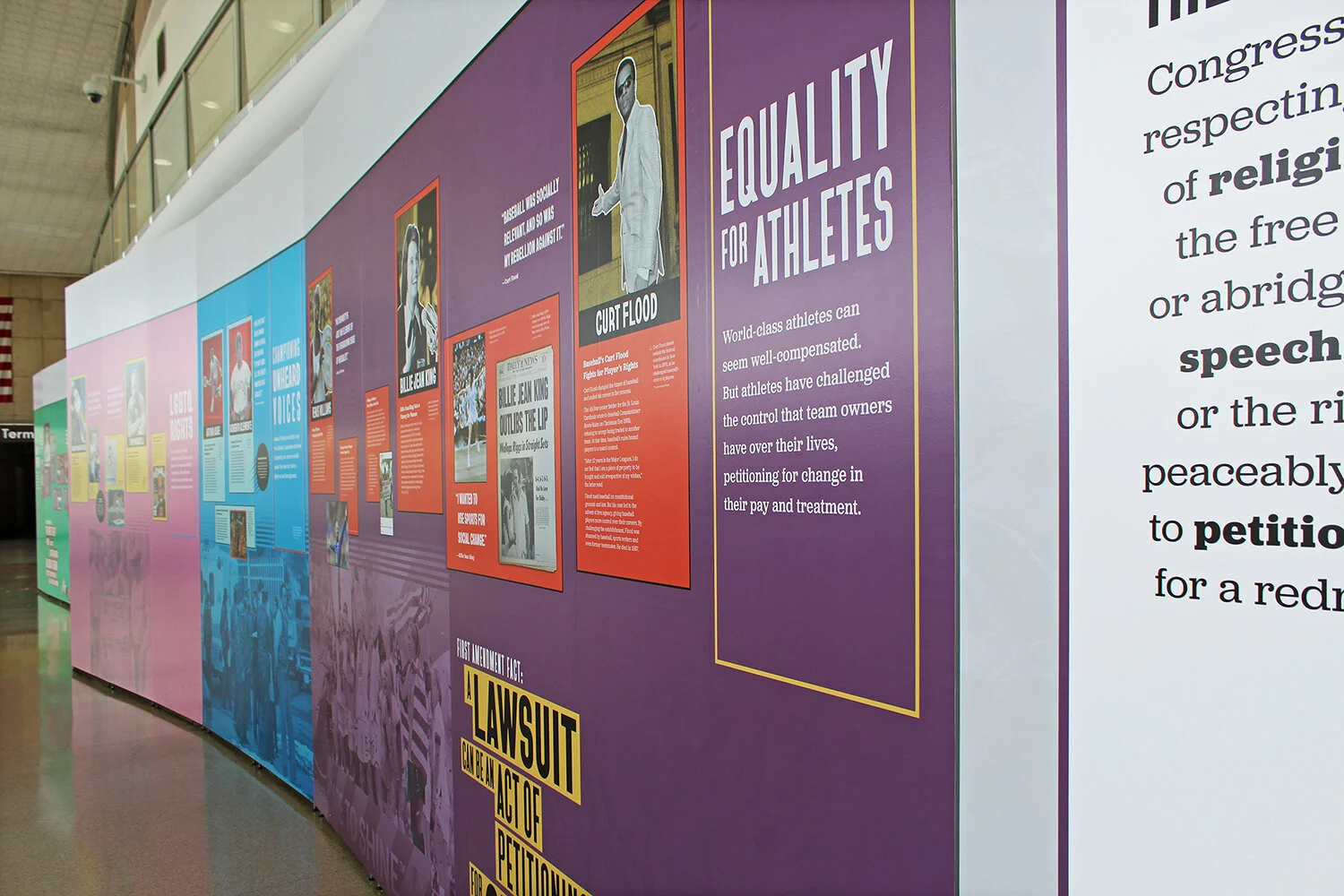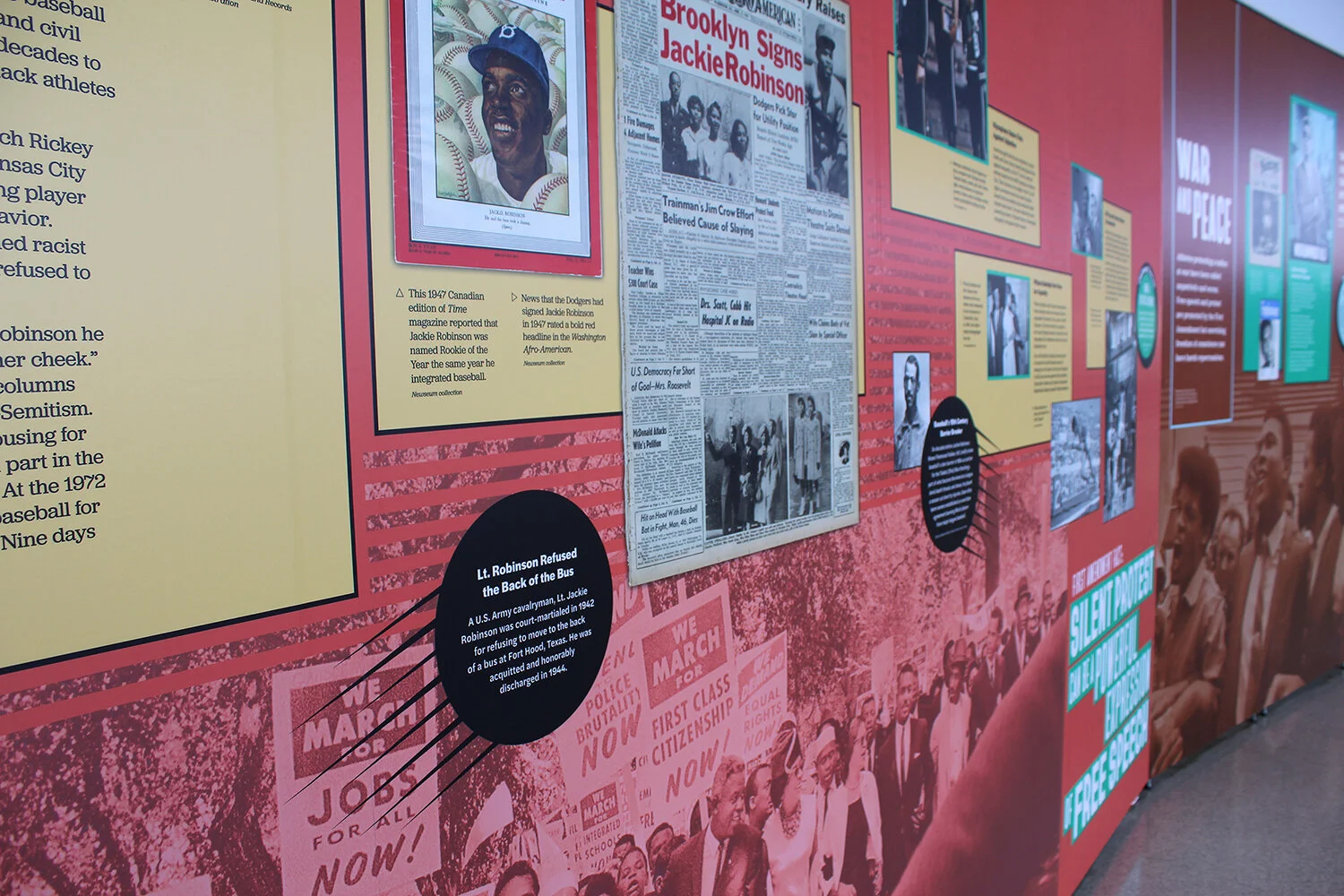PROJECTS
EXHIBITION DESIGN | EXHIBITION GRAPHICS
Freedom Forum (Newseum)
Dulles International Airport and Reagan National Airport, Virginia
Fair Play: Athletes Speak, Assemble, Petition for Freedom
February 2021 – June 2022
Christine Lefebvre Design teamed up again with the Freedom Forum to design their fourth “pop-up” exhibition, Fair Play: Athletes Speak, Assemble, Petition for Freedom. This temporary display highlights athletes who “use their fame to shine a spotlight on injustice … and exercise the freedoms guaranteed by the First Amendment — freedom of religion, speech, the press, assembly and petition — as they seek to make life’s playing field more even for all.”
Fair Play was installed in an unlikely location: two Washington, DC-area airports, and is part of a series of exhibitions that further the Freedom Forum’s mission to raise awareness of First Amendment freedoms through education. Thematically, it was organized into seven sections: The Fight for Civil Rights; War and Peace; A Matter of Faith; Racial Injustice; LGBTQ Rights; Championing Unheard Voices; and Equality for Athletes.
Design services included design concept development, exhibit organization, floor plans and elevations, graphic design, and final graphic production files.
The exhibition enjoyed an extended run from February 2021 through Spring 2022 at Washington Dulles International Airport, in Concourse B near Gate 50, and at Ronald Reagan Washington National Airport, in Terminal A.
Airport terminals presented an opportunity to reach a diverse audience, including individuals not otherwise inclined to visit an exhibition about this subject, or even museums in general. To catch the attention of busy travelers, the exhibition utilized a dynamic layout and energetic graphic design, with vivid colors, sporty stripes, and bold typography.
DULLES AIRPORT LOCATION At Dulles, Fair Play was restricted to a footprint of roughly 13.5 feet wide by 37 feet long. The floor plan was nicknamed “the race track” for its active, flowing pathway. Title and introductory text panels were arranged so that they would be seen first from any direction that a person might approach the exhibit.
REAGAN AIRPORT LOCATION At Reagan, the Fair Play exhibit is located in the long, curved, historic lobby of Terminal A (located between Terminals A and B). Floor plan options were limited, as the exhibit display could extend no further than one meter from the wall.
To allow for distinctions between the exhibit sections (The Fight for Civil Rights, War and Peace, etc), beyond just color palette changes, wall sections angle toward or away from the curved wall.
FONTS Fonts were intentionally chosen from the typographic work of historically excluded groups of designers. The typeface used for large headlines is called Bayard, named after Bayard Rustin, organizer of one of the most powerful expressions of freedom of assembly, the 1963 March on Washington. Inspired by protest signs used in the march, the typeface was created by Tré Seals, a Washington, DC-area Black designer. Other typefaces used in the exhibit are Jubilat and Halyard, by Black typographer Joshua Darden.
HIGHLIGHTED ATHLETES The graphic treatment for stories about highlighted athletes was inspired by classic baseball cards — specifically Jackie Robinson’s 1948 rookie card — with photographs silhouetted against duotoned backgrounds.
GRAPHIC MOTIFS To catch the attention of travelers, the exhibition utilized a dynamic layout and energetic graphic design, with vivid colors, sporty stripes, and bold typography.
“Why Do You Kneel?” and other prompts to “Challenge Yourself” provided moments for interaction and reflection throughout the exhibit. “Flying sportsball” quick facts provided visual movement, and First Amendment facts were prominent throughout.
Magazine covers and newspapers from the museum collection were incorporated graphically — since actual objects could not be displayed — giving a sense of immediacy and depth to the exhibition.
Credits: Exhibition Design and Graphic Design by Christine Lefebvre Design. Exhibition Development/Curation by Freedom Forum. Graphics were printed by EPI Colorspace (Gaithersburg, MD) and exhibits installed by Explus, Inc. (Sterling, VA).
Other Freedom Forum airport pop-ups designed by CLD: First Amendment Freedoms: Women Win the Vote | Front-Page News: The Rise and Fall of the Berlin Wall | Front-Page News: Man Walks on the Moon





















